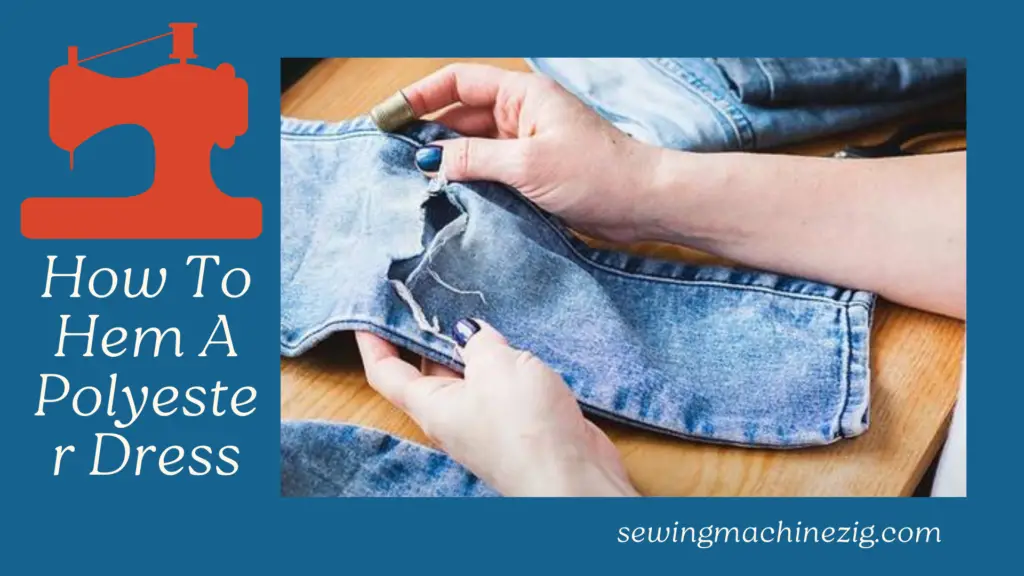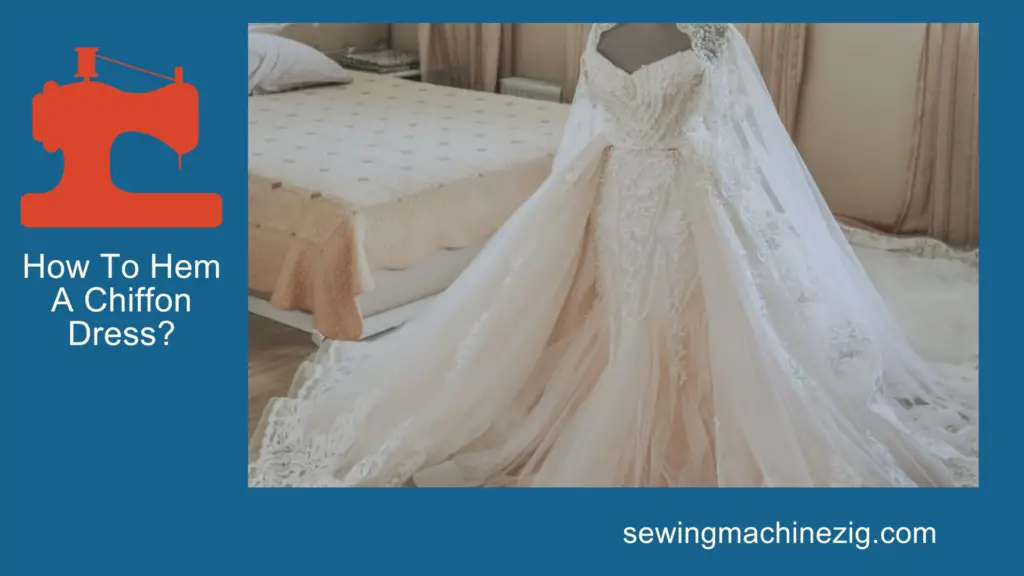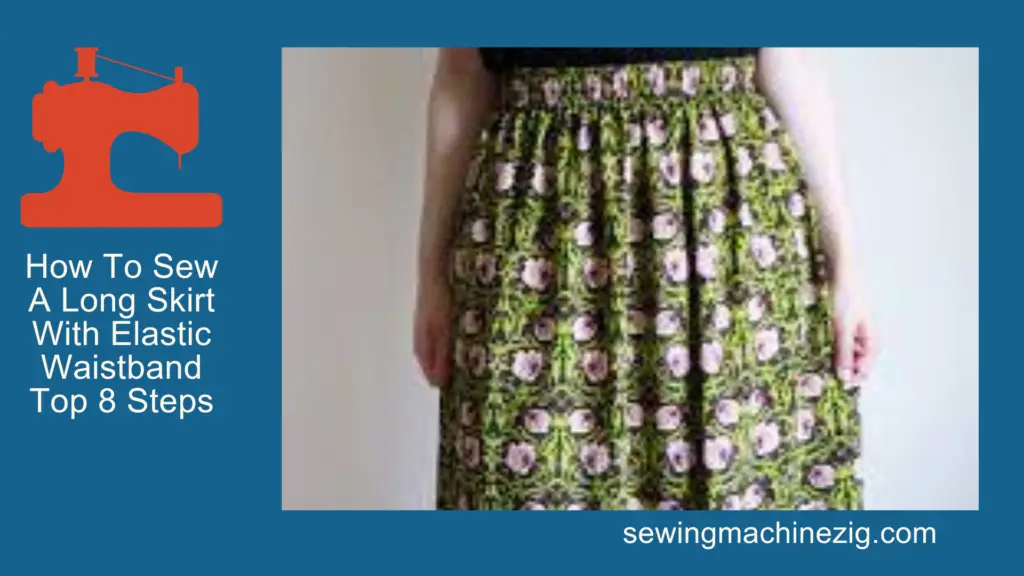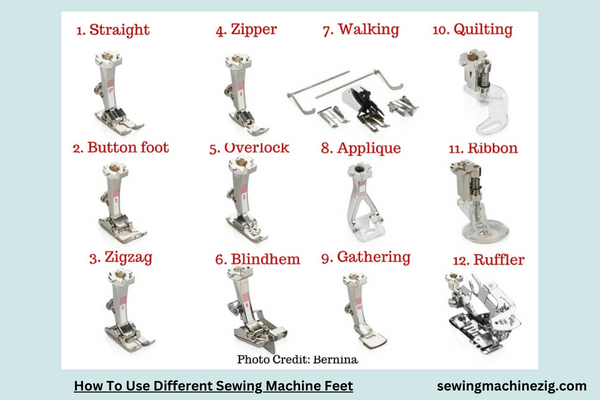
Unlock the full potential of your sewing machine by mastering the art of using different sewing machine feet. In this insightful guide on “How to Use Different Sewing Machine Feet,” we’ll explore the diverse array of feet available and their specific functions. From the versatile zigzag foot to the intricate quilting foot, each plays a unique role in enhancing your sewing projects.
Whether you’re a beginner or a seasoned sewist, understanding and utilizing various feet will elevate your craftsmanship, allowing you to tackle a wide range of stitches and techniques with confidence.
How To Use Different Sewing Machine Feet Detailed Answer
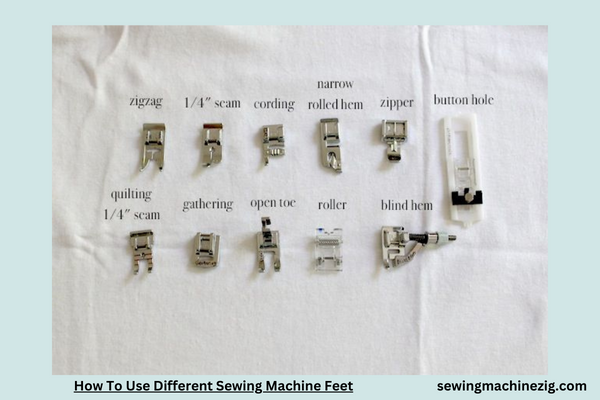
Mastering the art of sewing involves understanding and utilizing various sewing machine feet to enhance your projects. Here’s a comprehensive step-by-step guide on how to use different sewing machine feet, unlocking a world of possibilities for your sewing endeavors:
Step 1: Identify Your Sewing Machine Feet
Begin by familiarizing yourself with the different feet that come with your sewing machine. Common feet include the standard presser foot, zipper foot, buttonhole foot, walking foot, and more.
Step 2: Read Your Sewing Machine Manual
Consult your sewing machine manual to understand the functions and capabilities of each foot. The manual provides specific instructions tailored to your machine model.
Step 3: Attach the Standard Presser Foot
For general sewing, start by attaching the standard presser foot. Lift the presser foot lever, place the foot under it, and lower the lever to secure the foot in place.
Step 4: Switching to a Zipper Foot
When working with zippers, switch to the zipper foot. Loosen the screw on the presser foot holder, remove the standard foot, and attach the zipper foot. Tighten the screw to secure it.
Step 5: Installing a Buttonhole Foot
For creating buttonholes, attach the buttonhole foot. Some machines have an automatic buttonhole function. If not, adjust the settings according to your manual and guide the fabric as directed.
Step 6: Exploring the Walking Foot
The walking foot is ideal for sewing multiple layers or slippery fabrics. Install it by removing the standard foot, attaching the walking foot, and securing it with the presser foot lever.
Step 7: Utilizing the Overcasting Foot
Attach the overcasting foot for neat edge finishes. Adjust the stitch settings to overcast the raw edges of the fabric. Follow your machine’s manual for specific instructions.
Step 8: Trying the Quilting Foot
When quilting, switch to the quilting foot. This foot has a guide to help maintain consistent seam allowances. Adjust the needle position and stitch length as needed.
Step 9: Using the Blind Hem Foot
For invisible hems, opt for the blind hem foot. Adjust the settings for a blind hem stitch, fold the fabric accordingly, and guide it through the foot for a seamless finish.
Step 10: Experimenting with Decorative Stitches
Many machines come with specialty feet for decorative stitches. Explore these creative possibilities by attaching the appropriate foot and selecting your desired stitch.
Step 11: Monogramming with a Monogramming Foot
If your machine includes a monogramming or embroidery foot, use it for intricate designs. Follow your manual for guidance on setting up and executing monogram stitches.
Step 12: Testing and Adjusting
After attaching a new foot, test it on a scrap piece of fabric. Make any necessary adjustments to tension, stitch length, or other settings to achieve the desired result.
Key Tips:
- Organize Your Feet: Keep your sewing feet organized to easily locate and switch between them.
- Practice on Scrap Fabric: Before working on your actual project, practice using different feet on scrap fabric to familiarize yourself with their functions.
- Refer to Online Tutorials: Many online tutorials provide visual demonstrations of using specific feet. Watch these for additional guidance.
By following these step-by-step instructions on how to use different sewing machine feet, you’ll expand your sewing capabilities and achieve professional-looking results in various projects. Whether you’re a beginner or an experienced sewist, experimenting with different feet adds versatility and precision to your creations.
Can You Use Any Foot On Any Sewing Machine?
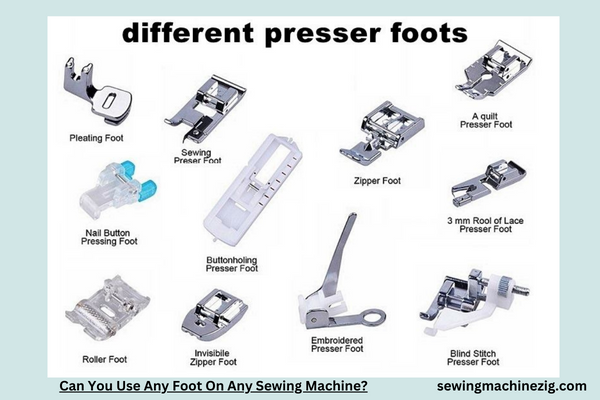
Using the appropriate presser foot is essential for achieving precise and professional sewing results. While many sewing machines come with a standard foot, the compatibility of different feet depends on your machine’s make and model. Here’s a detailed guide on whether you can use any foot on any sewing machine and how to determine the right fit:
Understanding Presser Feet Compatibility:
Check Your Sewing Machine Manual:
- The first step is to consult your sewing machine manual. It provides valuable information on compatible presser feet and any specific requirements for your machine.
Identify the Shank Type:
- Presser’s feet come with different shank types – low shank, high shank, or slant shank. Measure the distance from the screw to the bottom of the foot holder to determine your machine’s shank type.
Low Shank Machines:
- Most domestic sewing machines have a low shank, making them compatible with a wide range of presser feet. Low-shank feet are readily available and cover various sewing needs.
High Shank Machines:
- Industrial and some specialty machines have high shanks. Ensure you use presser feet specifically designed for high-shank machines to maintain proper alignment.
Slant Shank Machines:
- Some vintage machines feature slant shanks. It’s crucial to use presser feet specifically designed for slant shank machines to ensure they fit correctly.
Selecting the Right Presser Foot:
Standard Presser Foot:
- For general sewing tasks, the standard presser foot that comes with your machine is usually sufficient. It allows you to sew straight stitches and zigzags.
Zipper Foot:
- If your project involves inserting zippers, a zipper foot is essential. There are regular and invisible zipper feet, each serving a specific purpose.
Buttonhole Foot:
- Creating buttonholes is made easy with a buttonhole foot. Modern machines often have an automatic buttonhole feature that pairs with a specific foot.
Walking Foot:
- Quilters and those working with multiple layers of fabric benefit from a walking foot. It helps feed the fabric evenly, preventing layers from shifting.
Overcasting Foot:
- Overcasting feet are ideal for finishing raw edges, providing a clean and professional look. They are commonly used in garment construction.
Using Specialty Feet:
Embroidery Feet:
- Machines designed for embroidery often have specialized feet for decorative stitching. Check your machine’s compatibility with these feet for intricate designs.
Quilting Feet:
- Quilting feet come in various styles, such as 1/4-inch feet for accurate seams. Ensure your machine supports these feet for quilting projects.
While many sewing machines share compatibility with a range of presser feet, it’s crucial to reference your machine’s manual for specific guidance. Understanding your machine’s shank type and investing in feet tailored to your sewing needs ensures optimal performance and versatility.
Always explore the variety of presser feet available, experiment with different techniques, and enjoy the enhanced capabilities they bring to your sewing projects.
Different Sewing Machine Feet
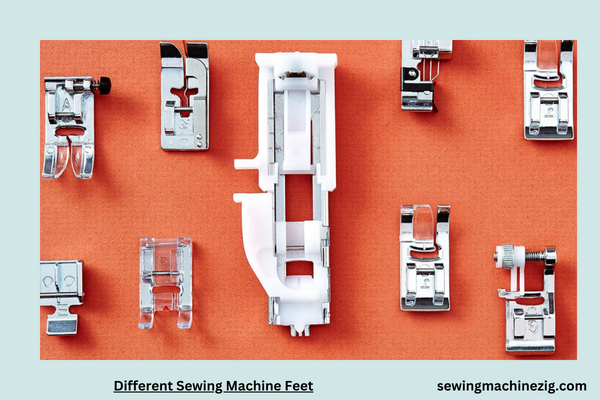
Sewing machine feet are essential accessories that enhance the functionality of your machine and open up a world of creative possibilities. Understanding the various types of sewing machine feet and their applications is key to mastering diverse sewing techniques.
In this detailed guide, we’ll explore different sewing machine feet, highlighting their purposes and how to use them effectively.
1. Standard Presser Foot:
- The standard presser foot is your go-to for everyday sewing tasks. It accommodates straight stitches and zigzags, making it versatile for a wide range of projects.
How to Use:
- Attach the standard presser foot by snapping it onto the presser foot holder. It’s suitable for most basic stitches and general sewing applications.
2. Zipper Foot:
- Zipper feet come in regular and invisible variations, allowing you to sew zippers seamlessly. They have a narrow design that enables precise stitching close to the zipper teeth.
How to Use:
- Attach the zipper foot according to your machine’s manual. Adjust the needle position to stitch alongside the zipper teeth, ensuring a neat and professional finish.
3. Buttonhole Foot:
- Creating buttonholes becomes effortless with a buttonhole foot. Modern machines often include an automatic buttonhole feature paired with a specialized foot.
How to Use:
- Select the buttonhole stitch on your machine. Place the button into the foot, and the machine will automatically stitch a perfectly sized buttonhole.
4. Walking Foot:
- Ideal for quilting and working with multiple layers of fabric, a walking foot ensures even feeding of layers to prevent shifting and distortion.
How to Use:
- Attach the walking foot and engage it while sewing. The foot’s built-in feed dogs work in conjunction with your machine’s feed dogs, aiding smooth and consistent fabric movement.
5. Overcasting Foot:
- Overcasting feet finish raw edges neatly, preventing fraying and adding a professional touch to your projects. They are commonly used in garment construction.
How to Use:
- Attach the overcasting foot and select the overcasting stitch on your machine. Guide the fabric edge along the guide on the foot for a clean finish.
6. Embroidery Feet:
- Sewing machines designed for embroidery often come with specialized feet for decorative stitching. These feet enable you to create intricate and artistic designs.
How to Use:
- Attach the embroidery foot and select the desired embroidery stitch on your machine. Experiment with different threads and techniques for unique embellishments.
7. Quilting Feet:
- Quilting feet serve specific purposes like achieving accurate seams. 1/4-inch quilting feet are popular for creating precise quilt blocks.
How to Use:
- Attach the quilting foot suitable for your project. Adjust the needle position to maintain the desired seam allowance, ensuring accurate piecing.
Exploring different sewing machine feet elevates your sewing experience, allowing you to tackle various projects with confidence and creativity. Regularly refer to your machine’s manual for guidance on foot compatibility and proper attachment. Experimenting with different feet expands your skills, enabling you to achieve professional results and bring your unique vision to life in every stitch.
Conclusion
In conclusion, mastering how to use different sewing machine feet opens up a world of creative possibilities in sewing. This comprehensive guide “how to use different sewing machine feet” empowers you to explore diverse techniques and applications, enhancing your sewing repertoire. Understanding the versatility of each foot ensures precision and efficiency, making your sewing projects more enjoyable and professional.
Regular practice with various feet allows you to harness their unique features, turning your sewing machine into a versatile tool for an array of tasks. Elevate your sewing skills by embracing the diverse functionality offered by different sewing machine feet. “how to use different sewing machine feet“
FAQS
Q: What is a sewing machine foot, and why is it important to use different types?
A: A sewing machine foot is a detachable accessory that attaches to the machine, guiding the fabric under the needle. Using different types of sewing machine feet enhances versatility, allowing you to execute various sewing techniques with precision. “how to use different sewing machine feet“
Q: How do I change sewing machine feet?
A: To change sewing machine feet, raise the presser foot, press the release lever to remove the current foot, align the new foot with the shank, and lower the presser foot to snap it into place securely.
Q: Can you provide guidance on using a zipper foot?
A: Absolutely. When using a zipper foot, attach it to the machine, adjust the needle position to align with the zipper teeth, and sew close to the zipper for a neat finish. This foot is perfect for installing zippers with accuracy.
Q: How do I utilize a walking foot for quilting projects?
A: To use a walking foot, attach it to the machine, engage the even feed mechanism, and sew multiple layers of fabric or batting evenly. This foot prevents layers from shifting, making it ideal for quilting and working with slippery or thick materials. “how to use different sewing machine feet“
Q: What’s the process for using an overcasting foot to prevent fabric fraying?
A: To use an overcasting foot, attach it to the machine, select the overcasting stitch, and guide the fabric along the foot’s guide. This foot creates a professional-looking edge, preventing fabric fraying and ensuring a clean finish. “how to use different sewing machine feet“
Q: How can I make the most of a blind hem foot for hemming garments?
A: When using a blind hem foot, attach it to the machine, fold and press the fabric to create the hem, and align the fabric edge with the foot guide. The foot’s guide helps in maintaining an even hem, and the blind hem stitch conceals the stitches on the right side of the fabric. “how to use different sewing machine feet“

